Cinque Terre
| UNESCO World Heritage site | |
|---|---|
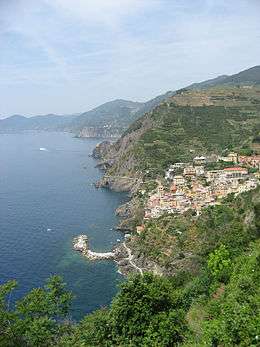 A view of the National Park of the Cinque Terre, showing Riomaggiore, one of the five coastal villages | |
| Location | Liguria, Italy |
| Part of | "Cinque Terre and Portovenere" part of Portovenere, Cinque Terre, and the Islands (Palmaria, Tino and Tinetto) |
| Includes | |
| Criteria | Cultural: (ii)(iv)(v) |
| Reference | 826-001 |
| Inscription | 1997 (21st Session) |
| Area | 4,511.54 ha (17.4192 sq mi) |
| Website |
www |
| Coordinates | 44°7′10″N 9°43′00″E / 44.11944°N 9.71667°ECoordinates: 44°7′10″N 9°43′00″E / 44.11944°N 9.71667°E |
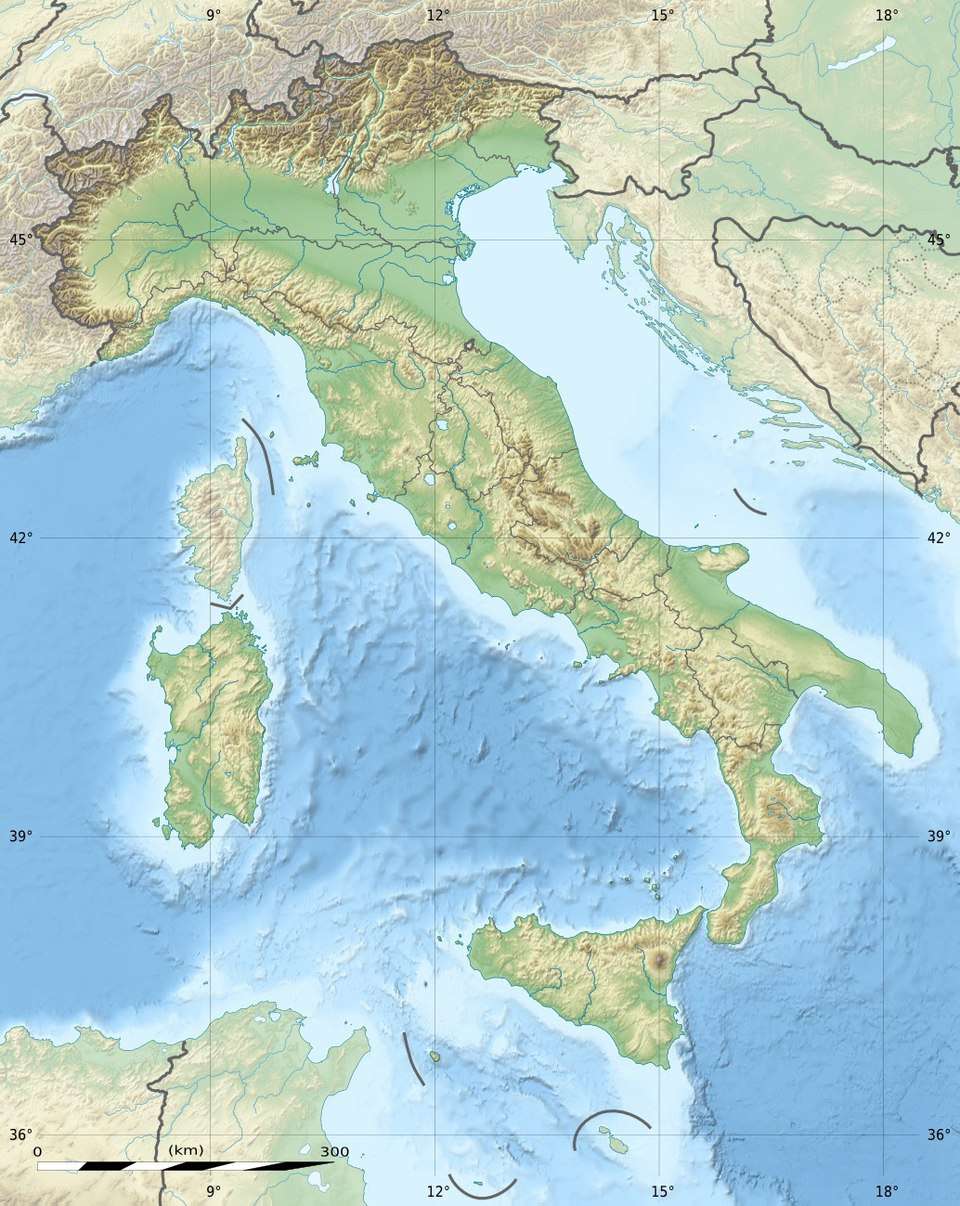 Location of Cinque Terre in Italy | |
The Cinque Terre (Italian pronunciation: [ˈtʃiŋkwe ˈtɛrre]; Ligurian: Çinque Tære, meaning "Five Lands") is a rugged portion of coast on the Italian Riviera. It is in the region Liguria, in the northwest of Italy, to the west of the city of La Spezia, and comprises five villages: Monterosso al Mare, Vernazza, Corniglia, Manarola, and Riomaggiore. The coastline, the five villages, and the surrounding hillsides are all part of the Cinque Terre National Park and is a UNESCO World Heritage Site.
Over the centuries, people have carefully built terraces on the rugged, steep landscape right up to the cliffs that overlook the sea. Part of its charm is the lack of visible corporate development. Paths, trains and boats connect the villages, and cars cannot reach them from the outside. The Cinque Terre area is a very popular tourist destination.
The villages of Cinque Terre were severely affected by torrential rains which caused floods and mudslides on October 25, 2011. Nine people were confirmed killed by the floods, and damage to the villages, particularly Vernazza and Monterosso al Mare, was extensive.[1]
History
The first historical documents on Cinque Terre date back to the 11th century. Monterosso and Vernazza sprang up first, while the other villages grew later, under military and political supremacy of the Republic of Genoa. In the 16th century, to oppose the attacks by the Turks, the inhabitants reinforced the old forts and built new defense towers. From the year 1600, Cinque Terre experienced a decline which reversed only in the 19th century, thanks to the construction of the Military Arsenal of La Spezia and to the building of the railway line between Genoa and La Spezia. The railway allowed the inhabitants to escape their isolation, but also brought about abandonment of traditional activities. The consequence was an increase in poverty which pushed many to emigrate abroad, at least up to the 1970s, when the development of tourism brought back wealth.
Contrary to the common belief that house colors originated to distinguish the fisherman's houses, they were not painted until the late 1970s. The only village that used fishing as its main industry was Monterosso. The locals lived off vineyards and olive cultivation.
Transport and tourism
There are few roads into the Cinque Terre towns that are accessible by car: the one into Vernazza is open as of June 2012, but very narrow at many places. It leads to a parking area a kilometre from town.
Local trains from La Spezia to Genoa and the rest of the region's network connect the villages of Cinque Terre. Intercity trains also connect them to Milan, Rome, Turin and Tuscany. The Cinque Terre tracks run most of the distance in tunnels between Riomaggiore and Monterosso. The Cinque Terre trains connect the La Spezia train station to all five towns. Unlimited day passes are available for tourists, and the trip from one village to another is five minutes or less.[2]
A passenger ferry runs between the five villages, except Corniglia. The ferry enters Cinque Terre from Genoa's Old Harbour and La Spezia, Lerici, or Porto Venere.
A walking trail, known as Sentiero Azzurro ("Azure Trail"), used to connect the five villages but the section from Riomaggiore to Manarola called the Via dell'Amore ("Love Walk") is closed. It is still possible to walk between these villages, although the trail is both steeper and longer than the (closed) path along the waterfront.
Culture
Literature
Limoni
The little path that winds down
along the slope plunges through cane-tufts
and opens suddenly into the orchard
among the moss-green trunks
of the lemon trees. [...] [3]
From the poem, “The Lemons”, 1921. This is how the Nobel Prize in Literature Eugenio Montale, through his poetry, tells of the beauty of Monterosso and how the Cinque Terre must be discovered.[4]
The Cinque Terre were not only a source of inspiration for Eugenio Montale but for many others as:
- Dante Alighieri who compares the Cinque Terre with the rugged cliff of Purgatory in the Divine Comedy.
[...]e allora in una tovagliuola bianchissima gli portò due fette di pane arrostito e un gran bicchiere di vernaccia da Corniglia[...][5]
- Gabriele D'Annunzio in his work Faville del Maglio cite the DOC white wine 'Sciachetrà':
...quel fiero Sciacchetrà che si pigia nelle cinque pampinose terre.[6]
Cinema
In 2013 Cinque Terre was one of the shooting locations of the movie The Wolf of Wall Street by Martin Scorsese.[7]
Food and wine
Given its location on the Mediterranean, seafood is plentiful in the local cuisine. Anchovies of Monterosso are a local specialty designated with a Protected Designation of Origin status from the European Union. The mountainsides of the Cinque Terre are heavily terraced and are used to cultivate grapes and olives. This area, and the region of Liguria, as a whole, is known for pesto, a sauce made from basil leaves, garlic, salt, olive oil, pine nuts and pecorino cheese. Focaccia is a particularly common locally baked bread product. Farinata, a typical snack found in bakeries and pizzerias, is a savoury and crunchy pancake made from a base of chick pea flour. The town of Corniglia is particularly popular for a gelato made from local honey (miele di Corniglia).[8]
The grapes of the Cinque Terre are used to produce two locally made wines. The eponymous Cinque Terre and the Sciachetrà are both made using Bosco, Albarola, and Vermentino grapes. Both wines are produced by the Cooperative Agricoltura di Cinque Terre, located between Manarola and Volastra. Other DOC producers are Forlini-Capellini, Walter de Batté, Buranco, Arrigoni.
In addition to wines, other popular local drinks include grappa, a brandy made with the pomace left from winemaking, and limoncello, a sweet liqueur flavored with lemons.
Preservation
In 1998, the Italian Ministry for the Environment set up the Protected natural marine area Cinque Terre to protect the natural environment and to promote socio-economic development compatible with the natural landscape of the area.[9] In 1999 the Parco Nazionale delle Cinque Terre was created to conserve the ecological balance, protect the landscape, and safeguard the anthropological values of the location.[10] Nevertheless, dwindling interest in cultivation and maintenance of the terrace walls posed a long-term threat to the site, which was for this reason included in the 2000 and 2002 World Monuments Watch by the World Monuments Fund.[11] The organization secured grants from American Express to support a study of the conservation of Cinque Terre. Following the study, a site management plan was created.
Neighbouring towns
Sister cities
Gallery
- Cinque Terre
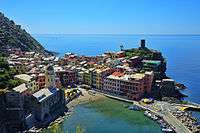
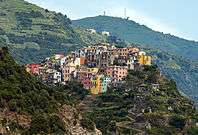
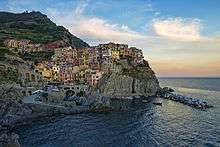
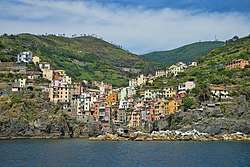
See also
- Asteroid 273994 Cinqueterre
- Liguria wine
References
- ↑ Squires, Nick (26 October 2011). "Villages all but wiped out as storms batter Italy's 'Cinque Terre'". The Daily Telegraph. Retrieved 6 August 2012.
- ↑ https://www.walksofitaly.com/blog/cinque-terre/train
- ↑ The Lemon Trees - Eugenio Montale
- ↑ Eugenio Montale and the Literary Park
- ↑ Testo del Decameron - Wikisource
- ↑ books.google.com, Introduzione alla Guida gastronomica
- ↑ Italy through its film sets
- ↑ Rick Steves' Best of Europe
- ↑ Istituzione dell'area naturale marina protetta denominata "Cinque Terre" Archived 2008-12-01 at the Wayback Machine. (G.U. della Repubblica Italiana n. 48 del 27 febbraio 1998)
- ↑ Istituzione del Parco nazionale delle Cinque Terre Archived 2009-02-27 at the Wayback Machine. (G.U. 17 dicembre 1999, n. 295)
- ↑ World Monuments Fund - Cinque Terre
External links
| Wikimedia Commons has media related to Cinque Terre. |
| Wikivoyage has a travel guide for Cinque Terre. |

